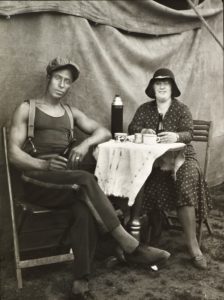Dr Stephan Ehrig reports on the IMLR/University of Liverpool study day at Tate Liverpool

August Sander,
Circus Workers, 1926-32
© Die Photographische Sammlung/SK Stiftung Kultur – August Sander Archiv, Cologne; DACS, London, 2017
The IMLR had jumped at the chance of hosting a study day on 30 September at Tate Liverpool’s fascinating exhibition Portraying a Nation: Germany 1919-1933 (on until 15 October), in collaboration with the University of Liverpool’s Department of Modern Languages and Cultures. The exhibition focused on the juxtaposition of two key German artists of the Weimar Republic: the photographer August Sander and the painter Otto Dix.
Sander’s photography, most notably his ambitious positivist project People of the 20th Century, presented in (almost) unbroken chronology, features authentic faces of the 1920s only divided into categories defined by profession or class. Tate combined this stream of images with a timeline of political, social, cultural and technical data of the Weimar Republic that presented the simultaneity of social, cultural and technical progress with the increase in political and ideological extremism in a genius way.
In contrast, Dix’s often grotesque and deliberately shocking portraits document the savage effects of war and prostitution and satirise the wealthy and influential. Sander’s photographic portraits of ordinary Germans can seem mundane, but that contrast offers a clue to their power. The apparent objectivity of the camera lens draws viewers into Sander’s documentation of the social reality of Germany between the two World Wars, inviting them to wonder what became of that overwhelming gallery of ordinary faces. Otto Dix’s paintings featured the war-impacted vision of the trenches and battlefield from a German expressionist perspective, and the many portraits of prostitutes, street children and capitalist factory owners added a completely different quality to Sander’s images. Therein lies the stimulating exquisiteness of this exhibition, and Liverpool can be very happy to be hosting this exhibition.
The study day gave us the chance to take the exhibition material to a different level and to further explore one of the most important and fascinating periods in twentieth-century history through the work of two of Germany’s greatest artists. If for many in the English-speaking world, the images of Berlin glamour and decadence in the hit musical Cabaret have come to represent the Weimar Republic, then the works of Otto Dix and August Sander offer a rather different set of images. Through lectures, discussions, and direct study of selected works in the exhibition, the study day set these works in a wider cultural, social, and political context, and at the same time explore the connection between art and politics at this most important cultural and political turning-point.
The day started with a lecture by Professor Frank Krause (Goldsmiths, London) who focused on the literary depictions of smell in German, French and English narratives of the Great War and therefore provided an excellent introduction to the impact of WWI on Weimar and European culture. His talk was followed by Professor Matthew Jefferies (Manchester) who elaborated on Sander and Dix with a special focus on the ‘strange revival of physiognomy in Weimar Germany’ which heavily impacted portraiture. After lunch, the participants of the sold-out event had the opportunity to walk through the exhibition (again, in many cases) and apply the content of the talks to the pictures themselves. A workshop followed, in which the speakers and audience discussed their ideas and impressions in smaller groups. The day ended with a talk by Professor Matthew Philpotts (Liverpool) who gave an outlook on both Sander and Dix after Weimar, through the Nazi period and after WWII.
The research day provided a unique opportunity to understand that historical moment directly through the portraits of those who lived through it and to learn from the artistic vision of those who were trying to make sense of it.
Dr Stephan Ehrig, teaching fellow in German, Durham University
